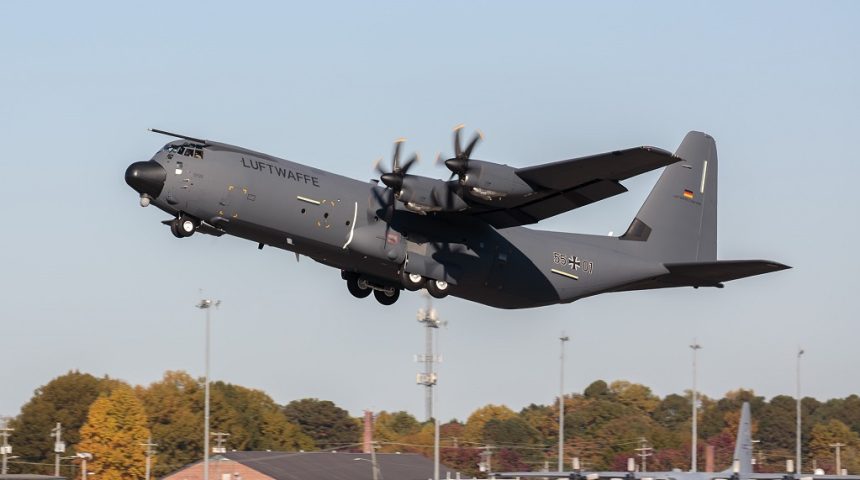The aircraft is the first of six C-130Js that will be operated together with four French ones in a joint binational squadron.
The Bundeswehr announced on November 8, 2021, the maiden flight of the first German C-130J-30 Hercules cargo aircraft out of Lockheed Martin’s facilities in Marietta, Georgia. The aircraft, with identification number 55+01 and serial number 5930, was rolled out of the assembly lines in July this year, before heading to the paint shop where it was spotted the next month with the new dark grey livery and Luftwaffe markings.
The U.S. Defense Security Cooperation Agency (DSCA) approved a Foreign Military Sale (FMS) to Germany in 2018 for three C-130J-30s (“stretched” variant of the standard C-130) and three KC-130Js (tanker variant). The aircraft will be delivered together with various equipment including Link 16 MIDS (Multifunctional Information Distribution System) datalink, ALE-47 countermeasures dispensers, AAR-47 Missile Warning Systems, ALR-56 Radar Warning Receivers, IFF and Wescam MX-20 Electro-Optical/InfraRed (EO/IR) imaging systems.
Die erste #C130J Hercules für die #Luftwaffe ist aus den Hallen bei @LockheedMartin gerollt. Nun geht es in die Lackierungshalle. Künftig wird der Transporter mit fünf weiteren deutschen Maschinen vom binational 🇩🇪🇫🇷 genutzten Standort Évreux aus starten. @lmeuropenews pic.twitter.com/guFG0PTygQ
— Team_Luftwaffe (@Team_Luftwaffe) July 22, 2021
Das wir weltweit schnell einsetzbar sind, haben wir bei der MilEvacOp gezeigt. Mit der #C130J erhalten wir die Fähigkeit „kleine Fläche“ nach Wegfall der #Transall. Die ersten Maschinen haben ihren neuen Anstrich bei @LockheedMartin bekommen. Mehr Bilder👉 https://t.co/wSLShVuU7E pic.twitter.com/O0lZIAa9OM
— Team_Luftwaffe (@Team_Luftwaffe) August 28, 2021
The German Air Force decided to acquire the Hercules to perform airlift, air drop and air refueling missions and close the capability gap that would have been generated by the retirement of the similarly sized C-160 Transall, which is planned to be retired at the end of the year after 53 years of service. In fact, even if the A400M Atlas can provide all the capabilities needed by the Luftwaffe, its large size represents a limit when operating from short or unprepared runways and when flying in support of the special forces, which is one of the capabilities mentioned when the C-130 procurement was announced.
The new Luftwaffe C-130Js will be part of a French-German joint squadron based in Évreux (France), which was officially established in September after years of planning. This binational air transport squadron will have unrestricted exchange of aircraft, air crews, and maintainers, as well as technical and logistical support based on a common pool of spare parts and a common service support contract. The six German aircraft will be joined by four French one, for a total of five KC-130Js and five C-130J-30s.

The first German C-130 is expected to be delivered to Évreux in February 2022, joining the already delivered French aircraft which were acquired in 2016 and delivered between January 2018 and February 2020. The delivery on the first Luftwaffe C-130 will also mark the Initial Operational Capability, while the Final Operational Capability is expected around 2024 with the delivery of the last aircraft. German crews are already training on the French C-130s, which were transferred from Orléans-Bricy to Évreux in July.
Im Februar 2022 soll die erste 🇩🇪 #C130J an den Standort Evreux geliefert werden. Die Vorbereitungen und die Ausbildung laufen auf Hochtouren. Die Umschulung der Piloten bei @LockheedMartin ist im vollen Gange. Alles dazu hier: https://t.co/pJmwiabTen pic.twitter.com/nQlGs4mPdn
— Team_Luftwaffe (@Team_Luftwaffe) November 3, 2021
“The French and German aircraft versions are very close, allowing the Franco-German teams to indiscriminately fly one aircraft or another,” a French defense ministry spokesperson said in an email to DefenseNews in September. The Luftwaffe confirmed in a news feature about the training on the new aircraft that its C-130J will be in the latest configuration, the Block 8.1, while the French ones are reportedly in the Block 6 configuration.
The binational squadron has been in the works for some years, with a first agreement in 2017. Both nations had to remedy to the capability gap generated by the retirement of their C-160 Transalls (which will continue to serve in France for a few more years), and the joint unit offered an occasion to lessen the logistical and economic burden for such a small fleet of aircraft. Lockheed Martin is building and equipping the training facility, with Thales and Rheinmetall jointly supporting the certification phase.









